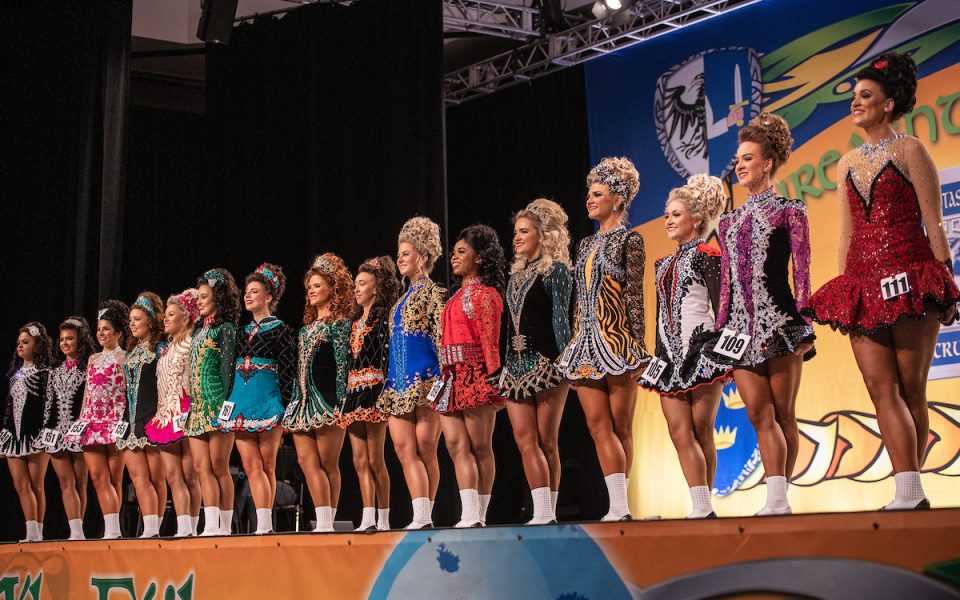Kelly King kicks her foot up in the air, so high that it looks like she could smack herself in the face with it. She steps swiftly back and forth on the stage, her bright-green bedazzled outfit glimmering as it refracts lights from above the stage.
King is one of the 5,000 dancers — including girls, boys, men and women — who gathered at the Koury Convention Center in Greensboro last week to compete in the 2019 World’s Irish Dancing Championship. It’s only the third time the competition, which is celebrating its 49th year, has been held in United States.
King says that of the 50 or so Irish dancers in the city, she and her sister were the only ones to qualify for the world championship.
Friends and fans, especially young girls, come up to King after her performance to congratulate her on her routine; a few ask for a photograph.
King’s been dancing since she was 4 years old. These days she practices at least three times a week, and in the months leading up to a major competition like this one, she also trains at a studio in Charlotte on the weekends.
“Time-management is the hardest thing,” says King, who is a sophomore studying business and marketing at UNCG.
When she’s not practicing, she’s teaching other kids to dance at her local studio.
“Dance is kinda my life,” King says.
Having traveled as far as Glasgow, Scotland to compete in the world championships last year, King says she was shocked when the competition came to her hometown.
“I never thought that in a million years that it would be held in Greensboro,” King says.
-

Kelly King (photo by Todd Turner) -

(photo by Todd Turner) -

(photo by Todd Turner)
The location was decided after the Greensboro Convention Center won a bid to host the competition. Since then, King says she’s been posting on social media accounts about things to do in the city. She’s even helped answer visitors’ questions like where to find good vegetarian food or where to get their nails done.
King competes in the ladies under-21 category and has won regionals the past two years and placed 33rd at last year’s world championships. This year is her seventh time competing on the world stage.
A look at the final scores on Sunday shows that King placed 27th this year.
Megan Whelan, a 28-year-old dancer from the Triangle, sits towards the side of the room, observing dancers like Kelly.
“I look at what I am doing versus what they are doing and learning how I can be better,” says Whelan, who didn’t qualify for the competition this year.
She’s been dancing since she was 12 but took a break to go to college when she was 18. She says she returned to dancing when she was 24 and has been trying to catch up ever since.
“I’ve always loved sports, but this is the one thing I could do forever,” Whelan says.

According to Orfhlaith Nibhriain, a spokesperson for the competition, the interest in Irish dancing is growing.
“The competitive scene is something that’s gone very global,” Nibhriain says. “Formerly it was people who had a link to Ireland or to Ireland’s diaspora but I would have to say that in a post-Riverdance, post-Lord of the Dance show scenario, we have people who are becoming part of that Irish dance community who… fell in love with the culture but don’t necessarily have actual family there.”
The simplicity of Irish dance is what makes it easy for anyone to get started, says Anne Hall, a dance teacher and marketing professional for the competition.
“It is rooted in a very traditional form of folk dance that is quite simple and can be learned by anybody,” she says. “Children after their first class, they can get up and perform a dance.”
Hall illustrates the light jig, the first two steps that every dancer learns in Irish dance. She kicks her foot in front of her body then folds her leg around her other leg, then slips it behind and repeats the movement.
“It goes from simple to more complex to even more complex,” she says. “There’s a continued refinement and progression that I find so very unique.”
And even though the dancing has its roots in tradition, Hall says the art form continues to change each year.
“We are not performing a standard form of dance,” she says. “Our dance continues to evolve. Teachers introduce new refinements and each year brings something new and yet we stay rooted.”
This year, dancers from Australia, Canada, the United Kingdom, Germany and even Mexico gathered at the world championships to compete after qualifying at one of the 27 regional competitions.
Nibhriain says the girls and women’s categories tend to be the largest but that there are several men and boys who compete too. And while many perform solo, several dancers also perform as a team.
-

(photo by Todd Turner) -

(photo by Todd Turner) -

(photo by Todd Turner)
In a large ballroom, Eva Ennis eagerly waits for her daughter Tara Shea, 17, to dance with her team. A group of eight girls, each dressed in pink with large, bouncy curls that would put Dolly Parton to shame, march onto the stage.
Ennis stifles her breath as she watches the girls hold hands, skipping and weaving swiftly through the rows during the routine.
“It’s evolved into a sport,” says Ennis who traveled from Savannah, Ga., to be here. “It’s kind of a way of life. My daughter knows nothing else.”
And that’s how Irish dancing is, says Hall. She says that the artform is addictive and kind of like a disease.
“Once you get the bug, you just are never really going to leave Irish dancing,” she says. “It stays with you for a lifetime.”
Learn more about the World Irish Dance Championship here.
Join the First Amendment Society, a membership that goes directly to funding TCB‘s newsroom.
We believe that reporting can save the world.
The TCB First Amendment Society recognizes the vital role of a free, unfettered press with a bundling of local experiences designed to build community, and unique engagements with our newsroom that will help you understand, and shape, local journalism’s critical role in uplifting the people in our cities.
All revenue goes directly into the newsroom as reporters’ salaries and freelance commissions.


Leave a Reply